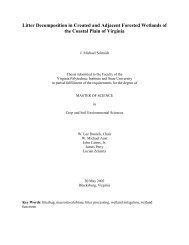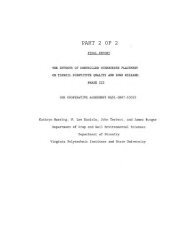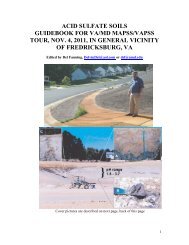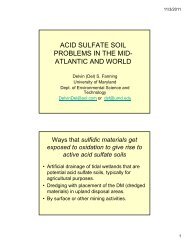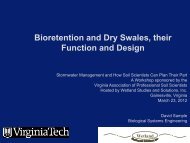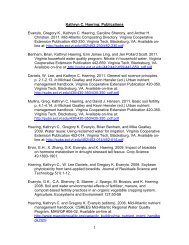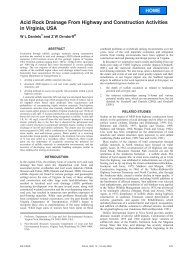Remediation of PAH-Contaminated Soils and Sediments: A ...
Remediation of PAH-Contaminated Soils and Sediments: A ...
Remediation of PAH-Contaminated Soils and Sediments: A ...
Create successful ePaper yourself
Turn your PDF publications into a flip-book with our unique Google optimized e-Paper software.
Biological Techniques for Enhancing <strong>PAH</strong><br />
Degradation (Bioremediation)<br />
Biodegradation is the biological transformation <strong>of</strong> molecules into smaller<br />
molecules with less toxicity (preferably water <strong>and</strong> carbon dioxide which is then<br />
termed “mineralization”). Bioremediation is the application <strong>of</strong> biodegradation to<br />
decrease pollutant concentrations (Olson et al., 2003). In this section, we will be<br />
discussing techniques to enhance biodegradation <strong>of</strong> <strong>PAH</strong>s during<br />
bioremediation.<br />
Several factors may limit the biodegradation <strong>of</strong> <strong>PAH</strong> in contaminated soils<br />
including (Alex<strong>and</strong>er, 1999; Olson et al., 2003; Straube et al., 2003; Harmsen et<br />
al., 2007):<br />
� limited supply <strong>of</strong> bacterial nutrient or carbon sources<br />
� nonoptimal abiotic conditions <strong>of</strong> temperature, pH, salts, oxygen<br />
concentration <strong>and</strong> toxins<br />
� lack <strong>of</strong> bacterial species that can degrade <strong>PAH</strong> compounds or low<br />
microbial biomass in general<br />
� low <strong>PAH</strong> bioavailability to degrading organisms<br />
� physiochemical characteristics <strong>of</strong> <strong>PAH</strong> compound<br />
Manipulations <strong>of</strong> the above limitations are the basis for bioremediation with the<br />
subsequent goals <strong>of</strong>: (1) improving soil microbial habitat through fertilizer<br />
additions, tillage, liming, <strong>and</strong>/or (2) plant establishment to promote microbial<br />
functional groups capable <strong>of</strong> degrading <strong>PAH</strong>s, while at the same time (3)<br />
increasing the bioavailability <strong>of</strong> the <strong>PAH</strong>s. Biostimulation techniques are used to<br />
improve the soil microbial habitat <strong>and</strong> bioaugmentation strategies manipulate the<br />
microbial community structure to make it more capable <strong>of</strong> degrading <strong>PAH</strong>s.<br />
Biostimulation<br />
Lack <strong>of</strong> sufficient carbon <strong>and</strong> nutrient sources to sustain the growth <strong>of</strong><br />
biodegrading microorganisms may affect bioremediation success (Odokuma <strong>and</strong><br />
Dickson, 2003; Ward <strong>and</strong> Singh, 2004). Nutrient <strong>and</strong> carbon additions can<br />
enhance microbial activities which may promote cometabolism (Untermann et al.,<br />
2000). Abiotic conditions can also affect ioremedation, since oxygen is <strong>of</strong>ten the<br />
most limiting factor in microbial growth. Oxygen can be manipulated through<br />
physical (l<strong>and</strong>farming, composting) <strong>and</strong> chemical (injection <strong>of</strong> manganese<br />
peroxide) techniques to stimulate microbial communities (Ward <strong>and</strong> Singh,<br />
2004).<br />
45



